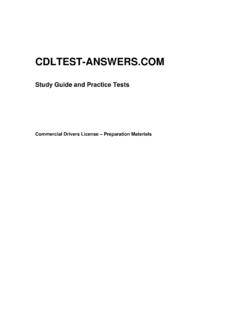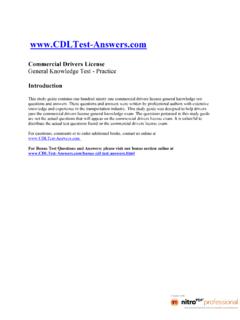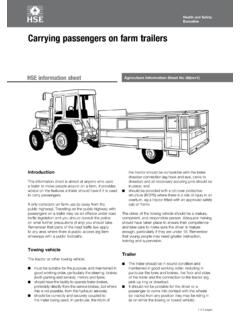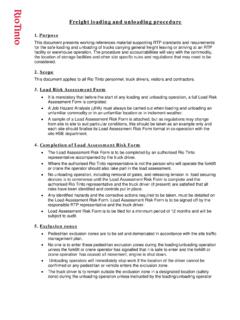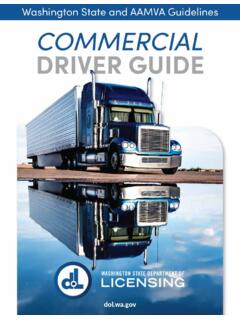Transcription of www.CDLTest-Answers
1 Commercial Drivers License Transporting Passengers Test - Practice Introduction This study guide contains eighty three commercial drivers license transporting passengers test questions and answers. These questions and answers were written by professional authors with extensive knowledge and experience in the transportation industry. This study guide was designed to help drivers pass the commercial drivers license passenger endorsement exam. The questions pertained in this study guide are not the actual questions that will appear on the commercial drivers license exam.
2 It is unlawful to distribute the actual test questions found on the commercial drivers license exam. For questions, comments or to order additional books, contact us online at For Bonus Test Questions and Answers: please visit our bonus section online at Transporting Passengers Practice Test Questions 1) Name one thing to check in the interior of the bus during the pre-trip inspection. a) Seats b) Seat belts c) Emergency exits d) Passageways 2) What is a hazardous material that you can transport by bus? a) Propane b) Gas c) Carbon dioxide d) Emergency medical supplies 3) What is a hazardous material that you can NOT transport by bus?
3 A) Propane b) Gas c) Carbon dioxide d) Emergency medical supplies 4) Where is the "standee" line? a) On the first step into the bus b) Directly behind the drivers seat c) At each emergency exit d) At the rear of the bus 5) Does it matter where you make a disruptive passenger get off of the bus? a) Yes b) No 6) How far from a railroad crossing should you stop? a) Between 25-50 feet b) Between 10-25 feet c) Between 15-50 feet d) Between 50-100 feet 7) Where must you stop before crossing a drawbridge? a) At least 50 feet before b) At least 100 feet before c) At least 75 feet before d) At least 15 feet before 8) The rear door of a transit bus needs to be opened to put on the parking brake.
4 A) True b) False c) Some do, some do not 9) If the bus is a charter and is carrying farm workers, how many seats may be placed in the aisle? a) 4. b) 6. c) 8. d) 0. 10) Why should you be alert for a road hazard? a) So you can help impaired drivers b) So you will have time to plan your escape if it becomes an emergency c) So law officials can be called d) So the accident reports will be accurate 11) When making a lane change, when should you check your mirrors? a) After completing the change b) Right after starting the lane change c) Before and after signaling the change d) All of these 12) When you discharge an unruly passenger, you must choose a place that is: a) The most convenient b) As safe as possible c) Dark and poorly lighted d) Off your regular route 13) Which one of the following should never be carried on a bus with passengers?
5 A) Emergency medical supplies b) Carbon dioxide c) Gas d) Tear gas 14) If your bus is equipped with an emergency exit door, it must: a) Not have any signs, markings or stickers near it b) Always have a red door light turned on c) Be secured when the bus is being driven d) All of these 15) A bus can carry freight or baggage in the passenger area, only if it is secured and: a) Riders are protected from falling packages b) All riders have access to all exits c) The driver can move freely d) All of these 16) How many folding aisle seats are permitted in bus that is not carrying farm workers?
6 A) 8. b) 6. c) 4. d) 0. 17) You may sometimes haul small arms ammunition, medical and hospital supplies on a bus. The total weight of such hazardous material should not be greater than: a) 750 lbs b) 500 lbs c) 250 lbs d) 100 lbs 18) When carrying passengers, you must never fuel your bus: a) With any windows open b) Without a static chain c) In a closed building d) With a higher grade of fuel 19) Which of the following about speed management and braking is True? a) The posted speed limit will always allow you to stop safely b) The total stopping distance for a bus is the distance it takes to stop once the brakes are applied c) You need about 4 times as much stopping distance to stop at 40 mph as you do at 20 mph d) Stopping time increases one second for each 10 mph over 20 mph 20) When is the best time to wear your seatbelt?
7 A) Always b) Only if the bus holds more than 27 people c) Only if required by the company policy d) Only when driving over 35 mph 21) When inspecting your bus, make sure that: a) Emergency exit handles are secure b) Rider signaling devices are working c) All handholds and railings are secure d) All of these 22) Your bus is disabled. The bus, with riders aboard may be towed or pushed to a safe place only: a) If getting off the bus would be more risky for riders b) If the distance is less than 500 yards c) By a 27,000 GVWR or larger tow truck d) By another bus, with 4 way flashers on 23) You must not allow riders to stand: a) Within 2 feet of a window b) Within 2 feet of an emergency exit c) In front of the standee line d) On top of the bus 24) Which of the following must you have on your bus?
8 A) Spare electrical fuses, accident report, accident reporting kit b) Fire extinguisher, spare electrical fuses, reflectors c) Hydraulic jack, fire extinguisher, flares d) Reflectors, fire extinguisher, accident reporting kit 25) If a rider wants to bring a car battery or a can of kerosene aboard the bus, you should: a) Have them use a seat belt b) Sit them next to an open window c) Send them to the rear of the bus d) Not allow them to do so 26) Buses may have recapped or regrooved tires: a) Anywhere except the front wheels b) Only on the front wheels c) Only when traveling less than 40 mph d) On any or all of the wheels 27) Emergency windows may only be opened halfway while driving a) True b) False 28) You should not change gears while crossing railroad tracks.
9 A) True b) False 29) When traveling at a safe speed, your bus should lean slightly to the outside on a banked curve. a) True b) False 30) Hazardous materials labels are diamond shaped. a) True b) False 31) All buses should be equipped with fire extinguishers and reflectors a) True b) False 32) Do not allow a passenger to stand forward of the rear of the drivers seat unless there is no room anywhere else. a) True b) False 33) If you are starting to get sleepy, it is a good idea to start a conversation with one of your passengers.
10 A) True b) False 34) Disruptive passengers should be discharged immediately. a) True b) False 35) A brake door interlock is to be used in place of a parking brake. a) True b) False 36) Never refuel your bus with riders onboard in a closed building. a) True b) False 37) You should stop at least 50 feet before a drawbridge without an attendee or a signal control. a) True b) False 38) Intersections are some of the most common places for bus crashes. a) True b) False 39) The posted speed for curves is always the safest speed for a bus.
